Basic concepts
The Slow flight lesson has introduced the student to the practice of flying close to the stall. Here you are furthering their knowledge by showing how the aeroplane behaves when there is not enough lift produced by the wings to balance its weight.
Many new terms and concepts will be introduced to the student during this briefing, and these should be kept as simple as possible.
When an aeroplane stalls, it is not like a car – the engine does not stop. The stall is a breakdown of the smooth airflow over the wing into a turbulent one, resulting in a decrease in lift. The lift will no longer fully support the aeroplane’s weight, and the aeroplane sinks.
For the basic stall we keep the aeroplane’s configuration as simple as possible, power will be at idle, flap will be up, and if applicable, undercarriage raised.
The student needs to know about stalling for three reasons. The first is to avoid an inadvertent stall. The stall does not just happen – there are many warning signs of its approach, and the student should be familiar with these.
To prevent the inadvertent stall, a pilot needs to be able to recognise the symptoms of an approaching stall, experience it, and then learn the correct recovery technique.
The second reason for being familiar with the stall was highlighted in the last lesson, Slow flight. There are a number of times an aeroplane will be operated at a speed close to its stall speed.
The most common of these, and the third reason, is the approach and landing phase of the flight. Every landing is a controlled approach to the stall.
To control the aeroplane to the point of stall, recognise the symptoms of the approaching stall, experience the stall itself, and recover with minimum height loss.
Having experienced the stall itself, repeat, only this time recover at stall onset with minimum height loss.
The basic stall is conducted in a power-idle clean configuration, ie, flap up.
The cause of the breakdown of smooth airflow is the result of the wing being at too high an angle of attack to the airflow.
A model aeroplane may be used to show that aeroplanes do not fly at an angle of attack of 90 degrees to the relative airflow. Therefore, somewhere between straight and level and 90 degrees, a limit is reached at which the air can no longer flow smoothly over the aerofoil.
For the average aerofoil used on general aviation aeroplanes, this limit is reached at an angle of attack of about 15 degrees. It should be emphasised that no matter what speed the aeroplane is flying at, when this angle is exceeded the aeroplane will stall because of the breakdown of the smooth airflow.
One way to do this would be, from straight and level, to close the throttle to idle and attempt to continue flying level.
In straight and level flight the angle of attack was about 4 degrees and the airspeed about ____ knots (see Figure 1a).
As experienced in Effects of controls, lift is primarily controlled through angle of attack and airspeed, and lift must equal the aeroplane’s weight to maintain level flight. As the airspeed decreases, the angle of attack must be increased to maintain lift equal to weight.
L = angle of attack x airspeed
As the angle of attack increases, the airflow finds it more and more difficult to follow the contoured upper surface of the wing (aerofoil) smoothly, and the point at which the airflow breaks away from the wing, the separation point, moves forward from the trailing edge. At the same time, the point through which lift acts, the centre of pressure (C of P), also moves forward along the chord line; this movement is unstable because it reduces the moment of the lift/weight couple (see Figure 1b).
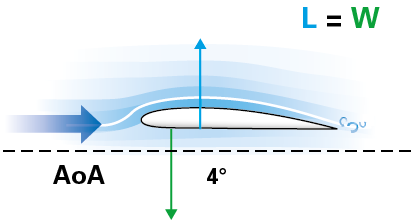
Figure 1a Straight and level flight
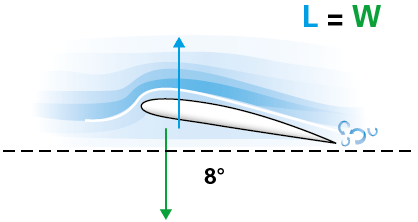
Figure 1b Increased angle of attack
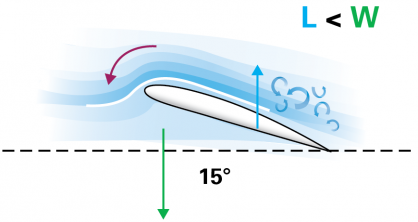
Figure 1c Stalling or critical angle of attack
Eventually, the stalling (or critical) angle of attack is reached, and the inability of the air to flow smoothly over the top surface of the wing results in a decrease in lift and a large increase in drag. This may be illustrated by the lift coefficient versus angle of attack graph (see Figures 1c and 2).
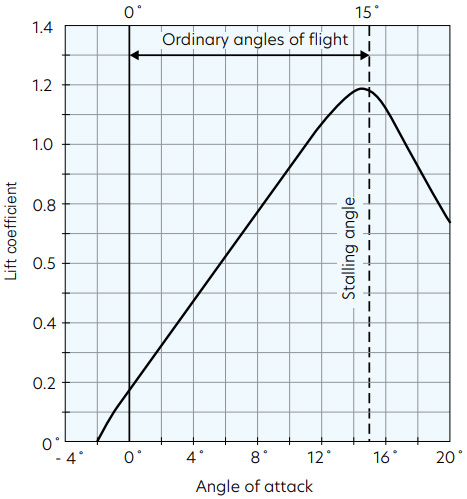
Figure 2 Lift coefficient versus angle of attack
The result is that the aeroplane sinks. At the same time, the centre of pressure moves rapidly rearward. The rearward movement of the centre of pressure increases the moment provided by the lift/weight couple, causing the nose to pitch down – a stable movement.
The factors affecting the stalling speed are discussed in Advanced stalling, the emphasis of this briefing is on the cause of the stall – exceeding the critical angle.
Passengers should not be carried during this exercise.
Situational awareness considers not only the position of the aeroplane three dimensionally within the training area, but also the warning symptoms of the approaching stall, and awareness of the flight phase – power set at idle, but attempting to maintain level flight.
Revise the HASELL checklist, incorporating those elements particular to stalling. This check is completed before the first stall.
H Height (not altitude)
Height sufficient to recover by not less than 2500 feet above ground level.
The altitude loss should be no more than 300 feet and the recovery height should provide an appropriate environment for practice.
Some organisations stipulate recovery by a height higher than 2500 feet AGL, consult your CFI.
A Airframe
The entry configuration is revised: idle power, flap up.
S Security
No loose articles, harnesses secure.
The basic stall in the modern light aeroplane is very gentle, but it is good aviation practice to secure loose articles to stop them moving around the cabin, and check harness security.
E Engine
Temperatures and pressures normal, mixture rich, fuel sufficient and on fullest tank.
Commonly the electric fuel pump is switched on to guard against an airlock (refer CFI). In addition, the carburettor heat may be cycled to ensure ice has not formed.
L Location
Not over a populated area and clear of known traffic areas, including aerodromes.
Stalling is not carried out over populated areas because large power changes are made throughout the exercise and may disturb people on the ground.
This exercise is not carried out near other aircraft.
L Lookout
Carry out a minimum of one 180-degree, or two 90-degree, clearing turns, to ensure other traffic will not result in conflict.
During the last part of the turn, start looking for a suitable reference point on which to roll out and use for the stall entry.
Introduce the HELL checks (a subset of HASELL) which are carried out between each subsequent stall.
H Height (not altitude)
Height regained or sufficient to recover by not less than 2500 feet above ground level.
E Engine
Temperatures and pressures normal.
L Location
Not over a populated area and clear of known traffic areas, including airfields.
L Lookout
One 90-degree clearing turn.
Common practice is to make these turns in the one direction (usually left) so that the exercise is carried out in a box over the same ground features. This general practice can be altered to allow for wind direction and strength (drift), the training area boundaries, and other traffic.
As large power changes will be made, it is appropriate to revise the requirement for smooth but positive throttle movements and the correct use of carburettor heat.
All preflight inspections should include a search for loose articles. Discreetly ensure a sick bag is available.
The regular turns and steeper than normal nose attitudes could lead to a level of disorientation – make sure the student has time between stalls to orientate themselves.
When you teach the stall you will need to gauge the student’s level of apprehension and provide appropriate reassurance in a calm professional manner. As the student gains more practice and exposure to stalling, their comfort level will increase, and they should become relaxed about stalling the aeroplane – but never complacent!
The effects of stress are reduced by overlearning the procedure, to produce an initial automatic response, and by experiencing the sensations of the stall, to desensitise the pilot. Tell the student that if they feel uncomfortable at any point, they should say so, the aeroplane can then be flown level, until they feel comfortable to continue.
HASELL checks are completed and a reference point on which to keep the aeroplane straight is nominated, confirm with the DI. Nominating a reference altitude is a function of the HASELL/HELL checks.
Because of the high nose attitude at the stall, choose either a high reference point or have the student sight one along the side of the engine cowling.
From level flight, carburettor heat is selected HOT and the throttle smoothly closed. As the nose will want to yaw and pitch down, keep straight with rudder and hold the altitude with increasing backpressure on the control column.
Through ____ knots, or when the aural stall warning is heard, select carburettor heat COLD, as full power will shortly be reapplied.
The first true symptom is a decreasing airspeed. Low airspeed and a high nose attitude are not always present in the approach to the stall. For example, the high-speed stall as a result of pulling out of a dive too sharply. Therefore, although it is desirable to inform the student that a high nose attitude and low airspeed are indicators of an approaching stall for most phases of flight, they will not always be present.
The next symptom is less effective controls as a result of the lowering airspeed – as they will have experienced in the Slow flight lesson. The student should also recognise the progressively increasing stick forces as the stall is approached.
Reduced control effectiveness is usually followed by the stall-warning device. However, this is not a true symptom, as the device is mechanical and may not work. The type and operation of the stall-warning device fitted to the aeroplane should be described.
The last generally noted symptom is the buffet. This is caused by the turbulent airflow from the wings striking the empennage. The effects of buffet are least noticeable in high-wing/low-tailplane aeroplane types, such as Cessnas. This is because the airflow breaking off the high wing combined with the high nose attitude, results in most of the turbulent airflow missing the empennage. Whereas in the low-wing/high-tailplane arrangement, for example the Piper Tomahawk, the turbulent airflow directly strikes the empennage and is very apparent.
At this point, as a result of the low airspeed, elevator effectiveness has been reduced to the point where no further increase in angle of attack can be achieved, even though the control column is held well (or fully) back. This results in the aeroplane sinking and the change in relative airflow causes the critical angle to be exceeded.
The aeroplane stalls, altitude decreases and (generally) the nose pitches down. It is important the student be able to correctly identify when the aeroplane has stalled.
The recovery is broken down into two distinct parts: unstalling the aeroplane, and minimising the altitude loss.
To unstall the aeroplane, the angle of attack must be reduced. Even though the aeroplane’s nose may have pitched down at the stall, the angle of attack is still high because the aeroplane is sinking. Since increasing the backpressure (or pulling back) increased the angle of attack, decrease the backpressure (or check forward). The ‘check forward’ with the elevator is a smooth but positive control movement – not a push.
In addition, no aileron should be used; ailerons must be held centralised, for reasons that will be discussed in the briefing Advanced stalling. However, the correct use of aileron must be stated right from the beginning in order to get the sequence right first time and every subsequent time.
You should be attempting to introduce stalling in its simplest and most basic form. Therefore, every effort should be made to avoid the wing-drop. If the aeroplane has a known tendency to wing-drop in the basic configuration it may be necessary to explain this tendency and the result, as well as the reason for not using aileron in the recovery (refer CFI).
If an explanation is required, keep it as simple as possible at this level. For example, “For various reasons one wing may stall before the other and this will produce a roll; ignore the roll (no aileron, aileron central, aileron neutral) and simply check forward.”
Your choice of terms – check forward, relax backpressure, ailerons neutral, no aileron, or ailerons central – should match your airborne patter.
It should be made clear that reducing the angle of attack is all that is needed to unstall the aeroplane. The aeroplane will enter a descent, and the student can now regain straight and level from the descent (PAT). The altitude loss will be about 300 feet using this method, and will be the first recovery method the student practises.
However, to minimise the altitude loss – Power + Attitude = Performance.
For the least loss of altitude, the maximum amount of power is required (hence carburettor heat COLD during the entry) so smoothly but positively apply full power (prevent yaw – keep straight) and raise the nose smoothly to the horizon. There is no need to hold the nose down, as excessive altitude will be lost. Similarly increasing backpressure too rapidly, or jerking, may cause a secondary stall.
Nose-on-the-horizon may be used as the reference attitude. Of the attitudes the student is familiar with the level attitude is too low and the aeroplane will continue to sink, resulting in unnecessary altitude loss. Alternatively, the climb attitude is too high, as the pitch-up created by full power combined with inertia may result in a secondary stall. In addition, the student should be discouraged from thinking that pulling back will make the aeroplane stop sinking – that’s how the stall was entered.
A compromise attitude is required to arrest the sink and allow the aeroplane to accelerate to the nominated climb speed. The simplest attitude to use is to put the top of the nose cowling just on the horizon. For some light aeroplanes this attitude is the same or similar to the climb attitude, but at least the student has not been encouraged to try to climb by simply pointing the aeroplane upwards.
The expected altitude loss should be stated, for example, not more than 100 feet.
The aeroplane should be held in the nose-on-the-horizon attitude until the nominated climb speed is reached and then the climb attitude selected.
Common practice is to use the recommended or normal climb speed, for example 70 knots. However, you may nominate speed for best angle of climb or for best rate of climb (refer CFI).
Straight and level flight should be resumed at the starting altitude and the reference point or heading regained if necessary.
All stalling exercises should finish with a recovery at the incipient stage, more commonly referred to as the onset. This is to emphasise that, under normal conditions of flight, the stall is avoided.
The second objective of this exercise is to recover at onset, which means at the stall warning or buffet.
The stall itself is simply the stall and is sometimes referred to as fully developed, meaning that the stall has occurred. A fully developed stall does not imply a wing-drop.
The expected altitude loss from a recovery at onset (depending on which symptom is first detected) should be stated, for example, less than 50 feet. With practice and improved situational awareness, this altitude loss can be reduced to zero – as the aeroplane is not permitted to stall (see Figure 3).
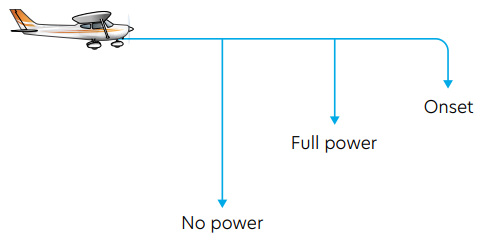
Figure 3 Recovery at onset of the stall
Make sure the preflight inspection identifies any loose objects and they are secured.
Encourage the student to take on more of the radio work, and to start their study for the radiotelephony exam.
Run through the checklists with the student, checking that they are learning the responses.
On the way out to the training area there is opportunity to practise climbing, straight and level and turning.
When setting the aeroplane up and choosing a reference point choose one into or with the wind to reduce any problems the student might have with drift perception.
Start with a demonstration of the basic stall and recovery, rather than the recovery at onset. Although the student is being taught to avoid the stall, they still need to experience what it is they are trying to avoid. During the demonstration the student should be advised to observe the high nose attitude, and asked to identify the actual stall so both instructor and student know they recognise the same thing.
In line with the objective of recognising the symptoms that warn of an approaching stall, the next step is to carefully demonstrate the symptoms.
The entry is pattered as “reference point, reference altitude, carburettor heat HOT, reduce power, keep straight and wings level.” Remind the student to look outside at the reference point to keep the wings level with aileron and straight with rudder – just a glance at the balance ball is all that is required.
From this point on, you can adjust the amount of backpressure to synchronise your patter to match the symptoms. For example, with practice you will be able to synchronise the words “and the stall warning sounds like [pause] that.”
The aeroplane can be held in the stall to demonstrate the buffet and the sink if required.
At the stall, the nose-down pitch is observed and identified by the student, and the normal recovery carried out by you without patter.
If the sink was discussed in the air exercise, this can be demonstrated only from a level entry. It is difficult to detect and may register as a ROD on the VSI, even though the elevator is held well or fully back, before the nose pitches down. The decision to include this demonstration depends on whether or not it was discussed in the air exercise, the aeroplane type, and ultimately the CFI.
Once the symptoms have been carefully demonstrated there is no need to rattle them off during every stall entry. Your patter can now be directed at the recovery.
The entry and recovery without power is pattered with the student following through. In addition, the student is given the opportunity to carry out the entry and recovery without power because this is the simplest recovery, and because checking forward centrally, when the nose is pitching down is not a natural reaction – but must be made through a conscious decision.
With the aeroplane in a glide descent the student can be asked to put the aeroplane into either straight and level flight (PAT) or directly into a climb (refer CFI) and the altitude loss noted.
Minimising the altitude loss is covered next. This requires the application of full power earlier than the previous student practice, and smoothly raising the nose to the horizon until the nominated climb speed is reached while stopping yaw with rudder.
If the benefits of power in reducing the altitude loss are to be seen clearly, you must ensure that during the demonstrations accurate altitude holding is maintained throughout the entry.
From this point the student is talked through and can practise. Remember, for this lesson, the correct recovery sequence of events is more important than speed or coordination of execution.
At the end of the airborne sequence, a recovery at onset should be carried out by the student. Common practice is to nominate a symptom at which the recovery will be initiated. For example, 60 knots, stall warning, or buffet (if the latter is easily detected).
If the student has practised slow flight and can recognise the symptoms leading up to the stall, they should be able to fly the aeroplane slowly and avoid an inadvertent stall.
This is an appropriate time to demonstrate a stall with power and flap (see the Advanced stalling lesson). Here, this manoeuvre is placed after the circuit lessons, but refer to your CFI for the point at which your organisation teaches it. If the Advanced stalling lesson is to be delayed until after the circuits, the student will benefit from seeing a stall with power and flap demonstrated before they undertake circuit training. It is important the student understands the recovery technique still requires a reduction in the angle of attack by checking forward.
On the way back to the aerodrome they can practise more straight and level flight, particularly concentrating on prompt and accurate trimming. As well as turning and descending, the student should be talked through the circuit and as much of the approach as you think they are capable of.
Debrief the student and remind them that there will be lots of opportunity to practise stalling, but the primary objective is to be able to recognise the stall and avoid the inadvertent stall.
Encourage the student to continue learning the checklists.
Basic stalling whiteboard layout [PDF 130 KB]
Revised 2023